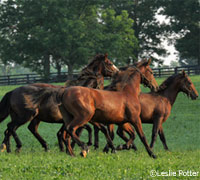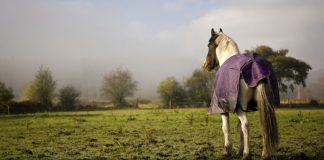 |
| Various forms of developmental orthopedic disease most often appears in foals and young horses that have not yet finished growing. Photo: Leslie Potter |
Every owner of a young horse hopes that the youngster will grow up to achieve his maximum potential. Consistent, high-quality nutrition and veterinary care will go a long way toward reaching optimal health and soundness in adulthood, but there are some abnormalities in growing horses that can put a wrench in those plans.
Osteochondritis dissecans
Commonly called OCD, Osteochondritis dissecans is the result of a defect in developing bone in young horses. In the case of OCD, flaps of bone or cartilage form on the joint surface, and in some cases those fragments detach and become debris floating around the horse’s joints. This can lead to pain and inflammation.
Many factors can cause OCD and the causes aren’t always clear. It may be partially genetic, but stress or trauma may contribute as well, especially in the case of horses started early in saddle training. OCD is fairly common in Thoroughbred race horses.
In some cases, OCD does not cause lameness at all. In other cases, heat and swelling may occur, but only minor lameness. In some cases, the horse may go through life with OCD, and the owner may never know it. However, if it does cause lameness, arthroscopic surgery to remove the bone pieces is a possible solution.
Subchondral bone cyst
The bone-against-bone movement of a joint is cushioned by a layer of cartilage and lubricating joint fluid. When a hole or gap in the cartilage occurs, the joint fluid can seep into the bone, causing irritation. This can lead to a subchondral bone cyst (SBC).
Primarily a developmental disease, SBCs occur most often in young horses, although they have been found in older adult horses as well. In some cases, SBCs are a secondary result of OCD. Direct injury to a joint can also lead to SBCs. In older horses (and humans), SBCs are associated with arthritis.
According to the Merck Veterinary Manual, SBCs are most common in the stifle, and are most frequently seen in young Thoroughbreds. They typically don’t cause any problems until the horse begins training under saddle. SBCs may appear as a mystery lameness when a young horse begins training. They don’t necessarily display heat or swelling, and they may appear fine after rest only to come up lame again once they restart work.
Some horses will improve with four to six months of rest and treatment with non-steroidal anti-inflammatories (NSAIDs, such as bute). In other cases, surgery may be the only option to bring an affected horse back to soundness.
Physitis
Growth plates, also called physes, are the sections at the ends of bones in young horses where the bone continues to grow and lengthen until the horse reaches his full size. In young horses, a syndrome of inflammation of the growth plates may occur. This syndrome is called physitis. Once a horse is full-grown, the growth plates ossify (solidify into bone). Horsemen often refer to the growth plates being “closed” at that point. Because adult horses no longer have growth plates, they are not at risk of physitis.
This syndrome often appears as swollen and sometimes sensitive areas just above a foal or young horse’s knees and hocks. It may cause lameness or stiffness of gait. Since it occurs in horses too young to be ridden, owners won’t notice an under-saddle lameness, but may notice that their youngster isn’t running or playing as much as usual. A diagnosis of physitis is typically confirmed by a thorough veterinary exam and radiograph.
Physitis may appear as a secondary problem in a foal that has another form of lameness. If the foal continues to favor one leg over time, the added weight on the supporting limb can essentially crush the growth plate. In the same way, early training, such as racetrack training of two-year-olds, can develop physitis due to the stress of exercise.
Physitis has also been found in young horses that are on rich pasture or are fed large amounts of concentrates (grain). Fast-growing horses such as Thoroughbreds are especially susceptible. In some cases, a bacterial infection in the growth plate can lead to physitis.
In mild cases, treatment may simply consist of diet alteration, confining the horse to a smaller area with soft footing to limit exercise, and NSAIDs such as bute ). to manage pain. Always consult your vet before beginning a treatment of NSAIDS, especially in young horses.
In other cases, treatment with antibiotics may be necessary.
If you suspect your young horse may have a form of DOD, consult your vet right away. Early treatment will help put him on the path to a sound and successful future.
Further Reading
Question of the Week: OCD





